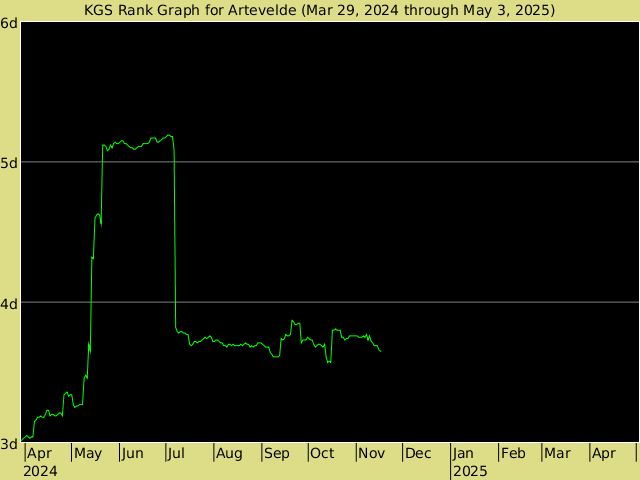DieterVerhofstadt/Studying with Minue
This page describes an abandoned personal project, but I want to keep it here in case I return to study in the future.
Homework
- Basic Haengma - 1. 48 problems. I solved 43.
- Basic Haengma - 2. 120 problems
- Basic life and death - 1. 40 problems. I got 28/40.
- Basic life and death - 2. 40 problems.
- Basic attack and defense - 1. 40 problems.
- Basic haengma - 3. 60 squeeze problems.
Online & offline lessons
- Homework review 48 problems.
- Game review of a game I won by luck, because my opponent failed to ignore my threats to an all important approach ko. I learned a few major things: leaning, desired direction of influence and the endgame value of a cut.
- a H3 teaching game. Here I learnt that, at least when playing someone stronger, I have a tendency to defend useless stones instead of moving to a large area. Another fine lesson is to keep track of the cash territory account: it directs one's efforts in developing moyos (they should become x points) or attacks (they should result in x points capture or destroy territory A).
- 120 more Haengma, labeled basic which means that according to Minue they should be standard repertoire for a 1 kyu. There were many many eye-openers in these exercises, a.o. the vital point of three stones (I know, but I don't play), the peep-aji of the double hanging connection (I know yet I played it), a tremendous amount of sabaki techniques and more leaning techniques.
- review of my first 2d victory, which was due to consistent play of mine but too slow and heavy play of my opponent. The most important problem is that in the middle game I play too thinly, chasing opponent groups so that my own positions become weaker or unclear at best. He went on to show thick plays that kept on the pressure, just like how he easily beat me with H3. Another hint was to probe territories before they become finalized and large.
- an article about the history and the power of the one space jump. Very entertaining and intriguing.
- 40 life and death problems review. Solved 28 #:-(
- crash game review, the one that made me drop back to 1d. A bad start at the bottom made me overplay at the top and neglect a weak group which got killed in a big way. We went into the Global joseki that potentially set off from this game's opening. I'll search gobase for these two whole board joseki.
- Homework review of the attack and defence. A lot about sweeping away the base of a two space extension in a strong sphere of influence. My hit rate was quite discouraging. I needed a break to absorb everything.
- Online 3-3 invasions.
- Homework review of the squeeze haengma, the attack & defence round 2 and the basic life and death - 2. A new insight comes from the Korean proverb Make weak walk along with weak.
- Discussions on thick and solid.
- Crash game review. A few opening and middle game heuristics which I overlooked in the game:
- Elementary endgame 1 and 2. 50 problems. Got about 6 to 8 wrong. I should try a little harder.
- Homework review: how to capture stones (19/30) and middle game positions which I have baptized "magical mystery tour". Also, explanation of a Global joseki.
Todo
- 3-3 invasions L&D: redo
- Middle game positions: review
Six years after I experienced the breakthrough to shodan I can really feel the improvement that should get me to something like 3-4 dan. The rank serves as a measurement only, because after all one should be able to apply newly learnt stuff in one's games. It is undeniable that a teacher lifts your level, but it must be a good teacher, or at least one that fits your needs and personality. Minue in my opinion is a great teacher. In the past I took a few lessons with Guo Juan. She too is very dedicated to her students. From her I remember the following learnings:
- Do not yield control over the centre. Take control yourself or make sure it becomes neutral.
- In each sequence, fight for sente.
- Technically, I learnt a lot about the ogeima from hoshi.
- We payed a lot of attention to hoshi corner patterns, since they lead to the start of the middle game and most of the joseki are not in standard books. In particular we studied -3 invasions.
Another popular teacher is Alexandre Dinerchtein. He used to be the champion of trick plays before he went to study in Korea, where they urged him to unlearn that habit. Yet in his commentaries (and I assume hence in his teaching) he pays a lot of attention to new, tricky corner variations. It's the nature of the beast. I'd like to learn from him too: a mixture of styles will surely provide a rich development.
The bottom line: if you have a few bucks to spend, find yourself a teacher! If you like Go, having a teacher is definitely a way to fall in love!
![[Diagram]](diagrams/12/bae6bc8f0b34857261839543520a0bcf.png)

![Sensei's Library [Welcome to Sensei's Library!]](images/stone-hello.png)